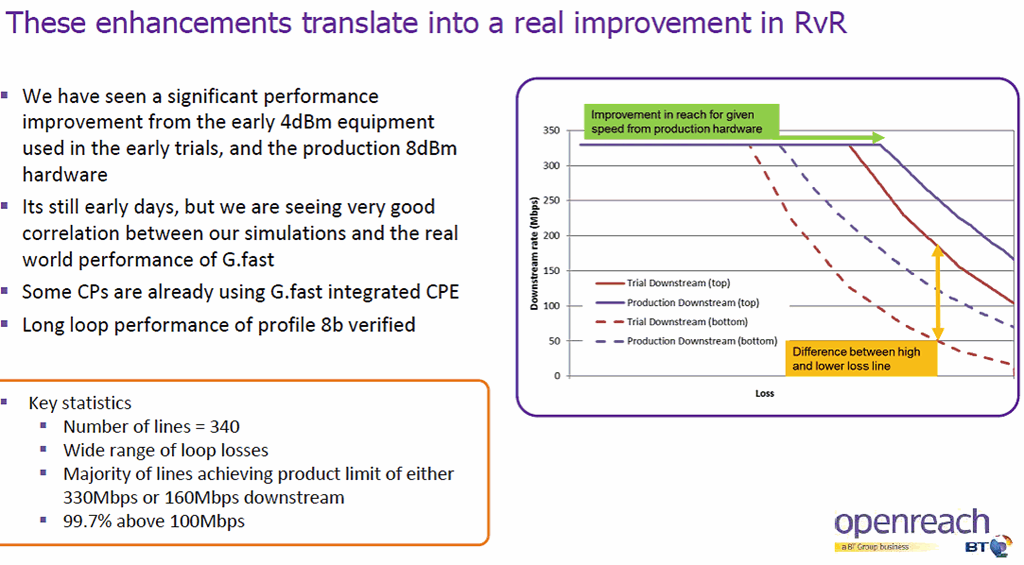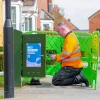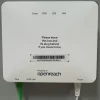Revealing G.fast’s Broadband Speed Improvement Since Openreach’s Trial
Some recent data from BT’s Head of Access Network Research, Trevor Linney, has revealed how much Openreach’s new 330Mbps capable hybrid fibre G.fast broadband technology has already improved since last year’s trial. Mmany more enhancements are on the way.
Back in 2015 Openreach predicted that it should eventually be able to deliver 300Mbps over a 350 metre copper line using G.fast (here), which reflects the cable that runs between a local PCP Street Cabinet (with a G.fast extension pod attached) and your home. Nevertheless the initial production hardware is still expected to fall some-way short of this and that’s because not all of the expected enhancements are ready for a live environment.
Proposed Future G.fast Developments (as stated in 2016)
* Enable higher bits per tone (12>14)
* Improve the receiver sensitivity (<-150dBm/Hz)
* Increase the transmit power (4>8dBm)
* Optimise the frequency usage with VDSL
* Increased vectoring group sizes (>96)
The last batch of data from Trevor Linney, which we covered just over one year ago (here), revealed that about 75% of lines on the operator’s field trial had achieved a download speed of over 300Mbps. However the same data also noted that 73.7% of those lines were shorter than 150 metres (rising to 87.4% for those under 200 metres). G.fast signals degrade over longer copper line distances so this gives us some useful context.
Advertisement
Openreach has now kindly furnished ISPreview.co.uk with some recent data from Trevor that reflects 340 active connections on the operator’s current pilot. This shows how much G.fast has improved since last year, although it lacks the crucial context of distance but you can probably make an educated guess from the chart.

Crucially other improvements are on the way, such as the ability to harness 212MHz of spectrum frequency (currently up to 106MHz) and the possibility of efficient spectrum sharing with existing VDSL2 (FTTC) broadband services, although those won’t be ready in time for the first commercial products. Openreach also has 96 port capable hardware (currently 48 max) from Huawei working in the labs but it’s not yet ready for the wild.
Over the longer term Openreach has also talked about boosting the top speed from 300Mbps to 500Mbps by 2025 but we’re still a long way from that. Some recent data from Thinkbroadband, which is based on a very small sample size and should thus be taken as highly tentative, may give us a rough indication of how G.fast is currently performing over different copper line distances and how many will benefit.
Advertisement
| Distance to cabinet (metres) | Estimated downstream speed | Estimated upstream speed | Cumulative %’age of premises at this distance |
|---|---|---|---|
| 100m | 500 Mbps | 50 Mbps | 11% |
| 150m | 300 Mbps | 45 Mbps | 20% |
| 200m | 250 Mbps | 40 Mbps | 31% |
| 300m | 150 Mbps | 20 Mbps | 52% |
| 370m | 100 Mbps | 20 Mbps | 64% |
The majority of those covered by a G.fast cabinet should thus expect to receive an “ultrafast broadband” speed of faster than 100Mbps (we note that Ofcom separately defines “ultrafast” as 300Mbps) but other issues, such as poor home wiring, may impact that figure (note: less than 100Mbps is G.fast’s fault threshold – details). The performance should then continue to improve as new enhancements are added.
One day it would be nice to see 300Mbps being achieved at a distance of around 300-350 metres but it looks like that might be difficult. In the meantime the operator’s pilot is set to reach 1 million homes and businesses across the UK by the end of 2017 (details). After that the commercial roll-out will then aim to reach a total of 10 million premises by 2020.
We suspect that the most popular G.fast package will be the 160Mbps tier, not least since the bulk of people should be able to receive this and its pricing should make it quite attractive.
Mark is a professional technology writer, IT consultant and computer engineer from Dorset (England), he also founded ISPreview in 1999 and enjoys analysing the latest telecoms and broadband developments. Find me on X (Twitter), Mastodon, Facebook, BlueSky, Threads.net and Linkedin.
« Sky Broadband Quietly Add 52Mbps FTTC Sky Fibre Unlimited Plus Package


















































Comments are closed